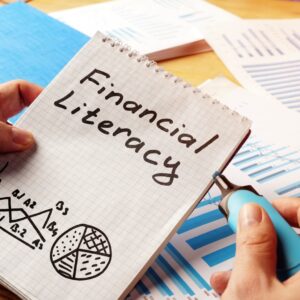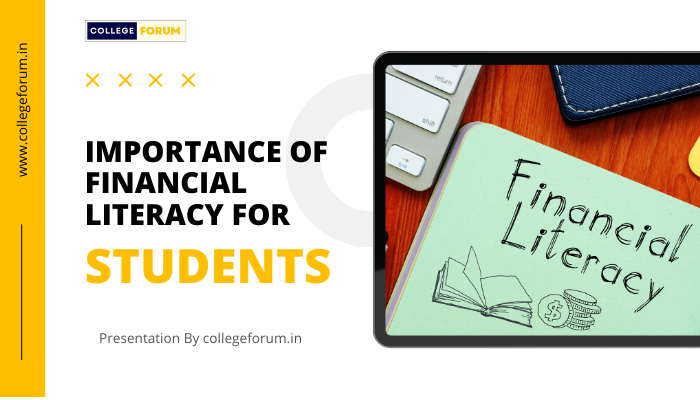Introduction
Financial literacy is the ability to understand and effectively use various financial skills, including personal financial management, budgeting, and investing. For students, developing financial literacy is crucial as it lays the foundation for a secure and prosperous future. Without a solid understanding of financial principles, students may find themselves struggling with debt, poor credit, and financial instability.
Understanding Financial Literacy

Basic Concepts of Financial Literacy
Financial literacy encompasses several core concepts such as budgeting, saving, investing, and understanding credit. These concepts are essential for making informed financial decisions and managing money effectively.
Importance of Financial Literacy in Daily Life
Having a good grasp of financial literacy impacts daily life significantly. It enables individuals to manage their finances, avoid unnecessary debt, plan for the future, and make informed financial decisions. For students, this means being able to balance academic pursuits with financial responsibilities, ultimately leading to a more stable and successful life.
Benefits of Financial Literacy for Students

Managing Personal Finances
Financial literacy empowers students to manage their personal finances efficiently. This includes creating and adhering to a budget, understanding income and expenses, and setting financial goals.
Avoiding Debt
A major benefit of financial literacy is the ability to avoid excessive debt. By understanding how credit works and the implications of borrowing, students can make smarter decisions that prevent long-term financial problems.
Planning for the Future
Financial literacy is crucial for future planning. Whether it’s saving for a major purchase, planning for retirement, or setting up an emergency fund, financial literacy provides the tools needed to prepare for the future.
Understanding Financial Aid and Scholarships
Students with financial literacy are better equipped to navigate the complexities of financial aid and scholarships. They can make informed decisions about borrowing and repaying student loans, and maximize the benefits of available financial aid.
Challenges in Promoting Financial Literacy

Lack of Awareness
One of the primary challenges in promoting financial literacy is the lack of awareness. Many students are not exposed to financial education early on, making it difficult to develop these essential skills.
Limited Access to Resources
Access to resources is another significant challenge. While there are many tools and resources available, not all students know where to find them or how to use them effectively.
Overcoming Misconceptions
There are many misconceptions about financial literacy, such as the belief that it’s only necessary for adults or those with substantial income. Overcoming these misconceptions is crucial for promoting financial literacy among students.
Strategies to Improve Financial Literacy Among Students

Incorporating Financial Education in Curriculum
Integrating financial education into school curriculums is one of the most effective strategies for improving financial literacy. This ensures that all students have access to the necessary knowledge and skills.
Utilizing Online Resources and Tools
There are numerous online resources and tools designed to improve financial literacy. Websites, apps, and online courses can provide valuable information and interactive learning experiences.
Workshops and Seminars
Hosting workshops and seminars on financial literacy can be highly beneficial. These events provide hands-on learning experiences and allow students to ask questions and receive guidance from financial experts.
Peer-to-Peer Learning
Encouraging peer-to-peer learning is another effective strategy. Students can learn a lot from their peers’ experiences and insights, making financial literacy more relatable and accessible.
Key Financial Literacy Topics for Students

Budgeting and Saving
Budgeting and saving are fundamental aspects of financial literacy. Students need to learn how to create a budget, track their spending, and prioritize saving to build a strong financial foundation.
Credit and Loans
Understanding credit and loans is essential for students. This includes knowing how credit scores work, the different types of loans available, and how to borrow responsibly.
Investment Basics
Investing can be a powerful tool for building wealth. Students should understand the basics of investing, the different types of investments, and the associated risks and rewards.
Understanding Taxes
Taxes are a critical aspect of financial literacy. Students should learn the basics of taxation, how to file taxes, and what deductions and credits they may be eligible for.
Budgeting and Saving

Creating a Budget
Creating a budget is the first step in managing finances. A budget helps track income and expenses, ensuring that spending aligns with financial goals.
Importance of Saving
Saving is essential for financial security. It provides a cushion for emergencies and allows for future investments and purchases.
Tips for Effective Budgeting
Effective budgeting involves tracking all income and expenses, setting realistic financial goals, and regularly reviewing and adjusting the budget as needed.
Credit and Loans

Understanding Credit Scores
Credit scores are crucial for financial health. They affect the ability to borrow money, rent apartments, and even secure employment.
Types of Loans
There are various types of loans, including student loans, personal loans, and credit cards. Understanding the terms and conditions of each type is essential for responsible borrowing.
Responsible Borrowing
Responsible borrowing involves understanding the costs associated with loans, such as interest rates and repayment terms, and borrowing only what can be repaid comfortably.
Investment Basics

Why Students Should Consider Investing
Investing can help students build wealth over time. Starting early allows more time for investments to grow through compounding.
Types of Investments
Common types of investments include stocks, bonds, and mutual funds. Each type has different risks and rewards that students should understand.
Risks and Rewards
Investing always involves risks, but understanding these risks and how to mitigate them can lead to significant rewards.
Understanding Taxes

Basics of Taxation
Understanding the basics of taxation, including different tax brackets and types of taxes, is essential for financial literacy.
How to File Taxes
Filing taxes can be daunting, but learning the process and using available resources can simplify it. Many schools offer resources to help students file taxes correctly.
Common Tax Deductions for Students
Students may be eligible for various tax deductions and credits, such as education-related expenses, which can reduce their tax burden.
Financial Literacy and Career Planning

Financial Planning for Career Goals
Financial literacy is crucial for career planning. Understanding how to manage finances can help students set and achieve their career goals.
Evaluating Job Offers
When evaluating job offers, students should consider not just the salary but also the benefits and financial implications of the position.
Understanding Employment Benefits
Understanding employment benefits, such as health insurance and retirement plans, is essential for making informed career decisions.
Financial Literacy and Mental Health

Financial Stress Among Students
Financial stress is a common issue among students. Managing finances effectively can reduce this stress and improve overall well-being.
Coping Strategies
Learning coping strategies for financial stress, such as budgeting and seeking support, can help students maintain their mental health.
Seeking Professional Help
Sometimes, seeking professional help from financial advisors or counselors can provide the necessary support to manage financial challenges effectively.
Real-life Examples of Financial Literacy Success

Stories from Financially Literate Students
Hearing from students who have successfully applied financial literacy principles can be inspiring and educational.
Impact on Their Lives
These success stories highlight the positive impact that financial literacy can have, from avoiding debt to achieving financial independence.
Resources for Improving Financial Literacy
Books and Publications
There are many books and publications dedicated to financial literacy. These resources can provide in-depth knowledge and practical tips.
Websites and Online Courses
Websites and online courses offer accessible and interactive ways to learn about financial literacy. Many of these resources are free or low-cost.
Financial Advisors and Counselors
Professional financial advisors and counselors can offer personalized advice and support, helping students navigate their unique financial situations.
Conclusion
In conclusion, financial literacy is a vital skill for students, providing them with the knowledge and tools necessary to manage their finances effectively, avoid debt, and plan for a secure future. By understanding and applying financial principles, students can set themselves up for success both during their academic careers and beyond.
FAQs
What is financial literacy?
Financial literacy is the ability to understand and use various financial skills, including personal financial management, budgeting, and investing.
How can I improve my financial literacy?
You can improve your financial literacy by educating yourself through books, online courses, workshops, and seeking advice from financial professionals.
Why is financial literacy important for students?
Financial literacy is important for students because it helps them manage their finances, avoid debt, and plan for their future effectively.
What are some common financial mistakes students make?
Common financial mistakes students make include overspending, not saving, accumulating debt, and not understanding credit.
Where can I find resources to learn more about financial literacy?
You can find resources to learn more about financial literacy through books, websites, online courses, financial workshops, and by consulting with financial advisors.

